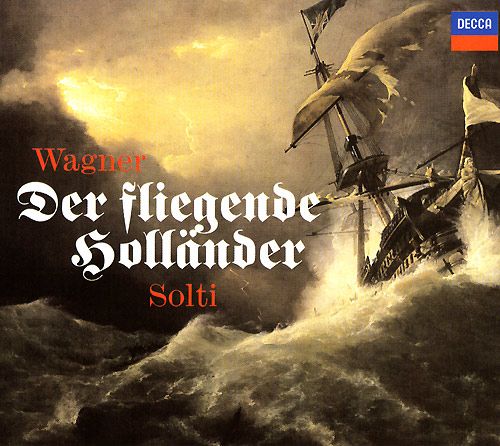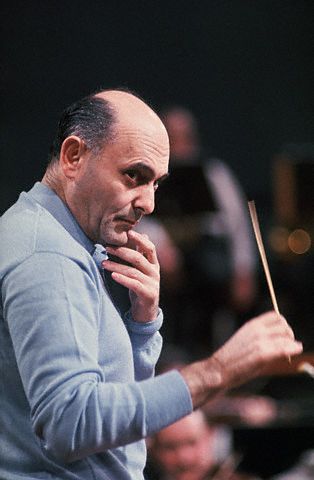wimpel69
12-20-2014, 06:43 PM
FLAC link below. This is my own rip.
Artwork & libretto (German/English) included. Do not share. Buy the original!
Please leave a "Like" or "Thank you" if you enjoyed this!
This legend of a Dutch sea captain cursed to sail the earth unendingly, only coming ashore
once every seven years to seek the selfless love of a woman, featured themes that would be of
enduring interest to Wagner: the theme of a wanderer in search of redemption reappears
several times in his later Ring des Nibelungen; that of redemption through a woman's act
of self-sacrifice appears both in Tannh�user and the Ring; and that of a pre-destined and
unbreakable love is central to both the Ring and Tristan and Isolde. In this and several
other ways the composition of Der Fliegende Holl�nder foreshadowed the events of the
composer's development as a mature composer.
Wagner's principal source for his opera about the Flying Dutchman was Heinrich Heine's
version of the legend in his Aus den Memoiren des Herren von Schnabelewopski,
published in 1834; but while Heine's retelling of the legend is ironic, Wagner stripped
it of these elements and instead focused on the elements of love and redemption.
The composer claimed that the work's inspiration was a stormy crossing from Riga to
London in August 1839; however, Wagner's original prose sketch was set not in Norway,
but Scotland, and Senta was originally "Anna." Wagner changed the setting to Norway
just a few weeks before the opera's premiere (in Dresden, January 2, 1843) in order
to distance it from a production of Pierre-Louis Dietsch's Le vaisseau fant�me, which
was also a setting of Wagner's libretto (he had sold it to the Paris Op�ra in 1841,
hoping to gain the commission for himself).
It is likewise not true, as Wagner claimed, that the entire work grew from the
"thematic seed" of Senta's Act Two ballad, although elements of the song do appear
in the Dutchman's monologue and in Erik's dream. This claim was most likely
Wagner's attempt to align this relatively early work with the thematic construction
of his later music dramas. However, Der Fliegende Holl�nder does show Wagner's
early moves toward large-scale form, and the blurring of divisions between musical
sections.
In many ways, Dutchman resembles its predecessors in German Romantic opera,
especially those with supernatural plots. Senta's portentous ballad in Act Two,
for example, resembles the prophetic song sung by the heroine of Marschner's
Der Vampyr, which Wagner helped prepare for performance in Wurzburg in 1833.
Wagner also uses dramatic devices such as the seemingly hypnotic state in which
the Dutchman and Senta first encounter each other, to emphasize the unearthly
nature and fatedness of the bond between them.
The Dresden premiere of Dutchman was not the success that Wagner had hoped.
Having bathed in the exaggerated splendor and grandeur of his Meyerbeerian
Rienzi, those in the audience expected a similar spectacle and were somewhat
disappointed. However, Der Fliegende Holl�nder quickly gained in popularity and
has remained a favorite. Perhaps the most familiar excerpts from the score are
the "Sailor's chorus" from Act Three and the "Spinning chorus" from Act Two,
which precedes Senta's ballad (which foretells of the Dutchman's presence),
but the Dutchman's joyful aria "Wie aus der Ferne l�ngst vergang'ner Zeiten"
and Daland's "M�gst du mein Kind" are also memorable.

Music Composed by
Richard Wagner
Played by the
Chicago Symphony Orchestra
With
Norman Bailey (Der Holl�nder)
Janis Martin (Senta)
Ren� Kollo (Erik)
Martti Talvela (Daland)
Werner Krenn (Der Steuermann)
Isola Jones (Mary)
And the
Chicago Symphony Chorus
Conducted by
Sir Georg Solti


Download Link - https://mega.co.nz/#!XRxzjSpC!VWRfagshVn0lon1FJz365lUdszJ8k8CH39wG81W 5JG8
Source: Decca, 1977 (my rip!)
Format: FLAC(RAR), ADD Stereo, Level: -5
File Size: 731 MB (incl. artwork & libretto)
Enjoy! Don't share! Buy the original! Please leave a "Like" or "Thank you" if you enjoyed this! :)
Artwork & libretto (German/English) included. Do not share. Buy the original!
Please leave a "Like" or "Thank you" if you enjoyed this!
This legend of a Dutch sea captain cursed to sail the earth unendingly, only coming ashore
once every seven years to seek the selfless love of a woman, featured themes that would be of
enduring interest to Wagner: the theme of a wanderer in search of redemption reappears
several times in his later Ring des Nibelungen; that of redemption through a woman's act
of self-sacrifice appears both in Tannh�user and the Ring; and that of a pre-destined and
unbreakable love is central to both the Ring and Tristan and Isolde. In this and several
other ways the composition of Der Fliegende Holl�nder foreshadowed the events of the
composer's development as a mature composer.
Wagner's principal source for his opera about the Flying Dutchman was Heinrich Heine's
version of the legend in his Aus den Memoiren des Herren von Schnabelewopski,
published in 1834; but while Heine's retelling of the legend is ironic, Wagner stripped
it of these elements and instead focused on the elements of love and redemption.
The composer claimed that the work's inspiration was a stormy crossing from Riga to
London in August 1839; however, Wagner's original prose sketch was set not in Norway,
but Scotland, and Senta was originally "Anna." Wagner changed the setting to Norway
just a few weeks before the opera's premiere (in Dresden, January 2, 1843) in order
to distance it from a production of Pierre-Louis Dietsch's Le vaisseau fant�me, which
was also a setting of Wagner's libretto (he had sold it to the Paris Op�ra in 1841,
hoping to gain the commission for himself).
It is likewise not true, as Wagner claimed, that the entire work grew from the
"thematic seed" of Senta's Act Two ballad, although elements of the song do appear
in the Dutchman's monologue and in Erik's dream. This claim was most likely
Wagner's attempt to align this relatively early work with the thematic construction
of his later music dramas. However, Der Fliegende Holl�nder does show Wagner's
early moves toward large-scale form, and the blurring of divisions between musical
sections.
In many ways, Dutchman resembles its predecessors in German Romantic opera,
especially those with supernatural plots. Senta's portentous ballad in Act Two,
for example, resembles the prophetic song sung by the heroine of Marschner's
Der Vampyr, which Wagner helped prepare for performance in Wurzburg in 1833.
Wagner also uses dramatic devices such as the seemingly hypnotic state in which
the Dutchman and Senta first encounter each other, to emphasize the unearthly
nature and fatedness of the bond between them.
The Dresden premiere of Dutchman was not the success that Wagner had hoped.
Having bathed in the exaggerated splendor and grandeur of his Meyerbeerian
Rienzi, those in the audience expected a similar spectacle and were somewhat
disappointed. However, Der Fliegende Holl�nder quickly gained in popularity and
has remained a favorite. Perhaps the most familiar excerpts from the score are
the "Sailor's chorus" from Act Three and the "Spinning chorus" from Act Two,
which precedes Senta's ballad (which foretells of the Dutchman's presence),
but the Dutchman's joyful aria "Wie aus der Ferne l�ngst vergang'ner Zeiten"
and Daland's "M�gst du mein Kind" are also memorable.

Music Composed by
Richard Wagner
Played by the
Chicago Symphony Orchestra
With
Norman Bailey (Der Holl�nder)
Janis Martin (Senta)
Ren� Kollo (Erik)
Martti Talvela (Daland)
Werner Krenn (Der Steuermann)
Isola Jones (Mary)
And the
Chicago Symphony Chorus
Conducted by
Sir Georg Solti


Download Link - https://mega.co.nz/#!XRxzjSpC!VWRfagshVn0lon1FJz365lUdszJ8k8CH39wG81W 5JG8
Source: Decca, 1977 (my rip!)
Format: FLAC(RAR), ADD Stereo, Level: -5
File Size: 731 MB (incl. artwork & libretto)
Enjoy! Don't share! Buy the original! Please leave a "Like" or "Thank you" if you enjoyed this! :)